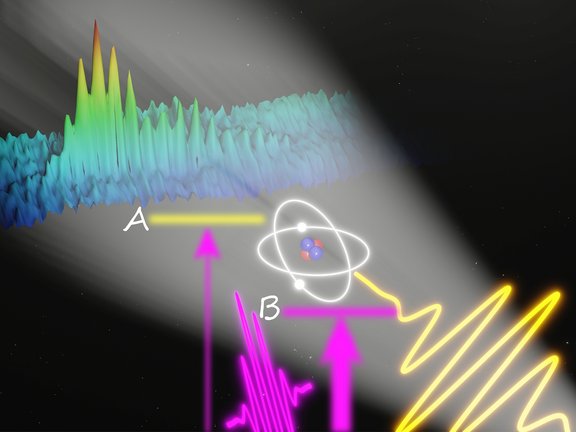|
With the invention of spectral analysis by Kirchhoff and Bunsen 1861 in Heidelberg a new era of physics began: Fingerprinting of elements became feasible by just looking at light emitted or transmitted by the substances in question, without the need to chemically analyse them. This opened new directions in many areas of science from microscopic to macroscopic scales including astronomy, where scientists were now able to analyse the chemical compositions of stars by their emitted light.
A chemical element emits a very unique pattern of light at different wavelengths, called spectral lines, that can be seen as a fingerprint of the element. However, these spectral lines have different intensities: while some are very prominently seen in the spectra, other are very faint and hard to detect.
With the development of quantum mechanics, it became clear that these lines correspond to very specific transitions between distinct energy levels of electrons in atoms. By absorbing photons of specific wavelengths, electrons can be transferred to different excited energetic levels, called quantum states. Electrons can return to their lowest energetically possible state by emitting photons.The differen
t line strengths in atomic spectra stem from the fact that due to the laws of quantum mechanics the transitions between different atomic energy levels come at different probabilities, depending on the quantum structure of the atom. In weak transitions, electrons tend to fall back to their lower ground state less frequently, resulting in a “sharper” linewidth but a low intensity of the line.
In modern physics, the weaker spectral lines are of great importance, as these correspond to very precise energetic transitions and can for example be used in the development of the most accurate optical atomic clocks. Their intrinsically small intensity, however, makes them hard to detect ― they are easily hidden by experimental background or stronger lines nearby.
To overcome these limitations physicists again from Heidelberg developed an experimental trick to improve the signal strength of these lines significantly: A short laser pulse is used to not only excite electrons to the quantum state of interest (A), but additionally to another state (B) nearby that can be more easily populated. By applying a second, more intense laser pulse the electrons then get transferred from this “wrong” excited state B to the actual target state A. This leads to a much larger population of electrons in that state A and thus more electrons will return to their ground state by emitting photons, resulting in a greatly improved line intensity.
By implementing this method on a setup using Helium atoms, the scientists from the Max-Planck-Institut für Kernphysik, together with their cooperation partners at University of Tsukuba in Japan, Max-Planck-Institut für Physik komplexer Systeme in Dresden and Louisiana State University in the USA, were able to significantly enhance the spectral visibility of two weak transitions, as can be seen in Fig. 1. “We envision this method to be applicable in many different atomic systems in which certain transitionsare thus far too weak to determine precisely, as well asin the spectral diagnostics of complex biomolecules” explains Yu He, one of the lead authors of the recently published study. In follow-up studies the researchers plan to apply this technique to other atomic and molecular quantum systems.
Originalpublikation:
Bringing weak transitions to light
Yu He, Xiao-Min Tong, Shuyuan Hu, Gergana D. Borisova, Hao Liang, Maximilian Hartmann, Veit Stooß, Chunhai Lyu , Zoltán Harman, Christoph H. Keitel, Kenneth J. Schafer, Mette B. Gaarde, Christian Ott and Thomas Pfeifer
Nature Communications 16, Article number: 5322 (2025). DOI: 10.1038/s41467-025-60701-9
Weblinks:
Group “Excited atoms and molecules in strong fields” (Division Pfeifer) at MPIK
